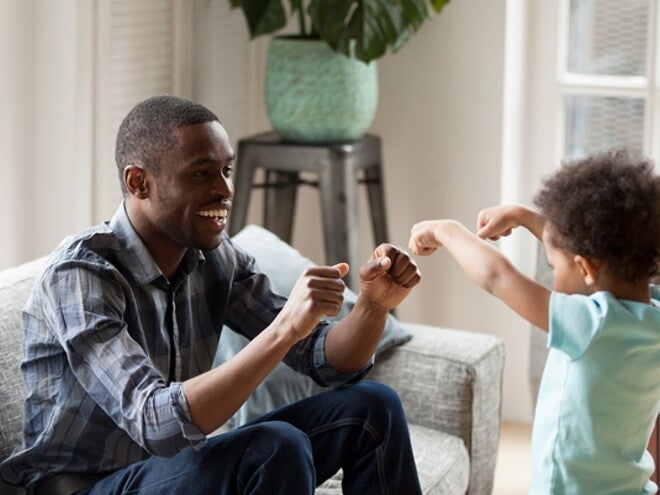
Three-year-olds start to develop a sense of their body and what they can do with their body parts. They will soon start to add eyes to circles when they scribble. Lines extending out of a circle represent arms or legs. Children typically do not draw people with distinct heads and bodies before age four.
Identifying body parts: Typical three-year-olds can learn to show and name basic body parts: head, feet, hands, eyes, mouth, nose, ears, hair, tongue, tummy, arms, legs, back, shoulders, knees and fingers. Many can also show and name their thumb and forefinger.
Developing a sense of position in space: To do this, you can raise the bar by asking your child to place their hands above, below, in front, behind and beside certain body parts.
Raise a competent mover with “ABC”
Play “ABC” games to scaffold your child – between the ages of three and five – on their way to becoming a competent mover.
A-GAMES are aimed at developing a strong athlete
Think of a capital letter A and see a stick figure with its legs planted far apart, standing strong.
This represents physical strength and endurance. In other words, you need to play games that aim to develop skills that you would associate with a gymnast (balancing) or a rugby player (scoring a try). Such an athlete is strong, agile and fast and has impressive co-ordination and balancing skills.
B-GAMES help children to understand their bodies better
Young children are designed to learn, slowly but surely, from what their eyes, ears, skin and muscles tell them as they move and explore. They tune into their bodies and relate to their surroundings in four ways:
- They develop a body scheme (“body awareness”) as they discover where different body parts are and what they can do. This leads to developing something called “midline crossing”, where they learn to feel comfortable with moving the right hand across the midline of the body and using it while it’s on the left side and vice versa.
- They develop “spatial awareness” as they learn about position, distance and speed. They discover how much space their bodies occupy, how to use their bodies in the space that is available and how their bodies take on different shapes as they assume different positions.
- Children also learn about the direction of movement by sensing the left and right sides of their own body, and then using that inner sense of direction to relate to all the other directions in which their bodies, and objects around them, can move (called “directional awareness”).
- They develop “temporal awareness” as they practice moving their bodies in relation to rhythm and time. This makes it possible for them to understand how sequences are put together and it prepares them for being able to follow and create patterns – a skill necessary for learning to read, write and do mathematics.
C-GAMES help children to develop movement vocabulary
Children need to know different basic “moves” for them to learn specialised sports skills in primary school. This is the same as learning numbers in order to learn maths or the letters of the alphabet in order to read and write.
Think of a C and turn it on its side to form a bowl. Now…think of the fundamental movement skills that pre-schoolers are introduced to: rolling, balancing, sliding, jogging, running, leaping, jumping, hopping, dodging, galloping, skipping, bouncing, throwing, catching, kicking and striking.
Imagine adding those movement skills to the bowl one by one. This represents you building your child’s movement vocabulary.
Tip: Develop your three-year-old’s sport skills
You can provide enough skills by keeping the letters “ABC” in mind.
A-games point to games that build strength and stamina. Pulling up on monkey bars and running up and down a flight of stairs are A-games that build strength and develop balance and coordination.
B-games focus on developing body awareness. Pointing to body parts with eyes shut and doing an obstacle course develop body awareness.
C-games involve teaching fundamental movement skills. Things like teaching your child to kick or throw a ball, swing a bat, stand on one leg, or balance on a kerb as the two of you walk around the block fall into this category.